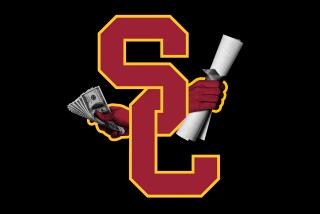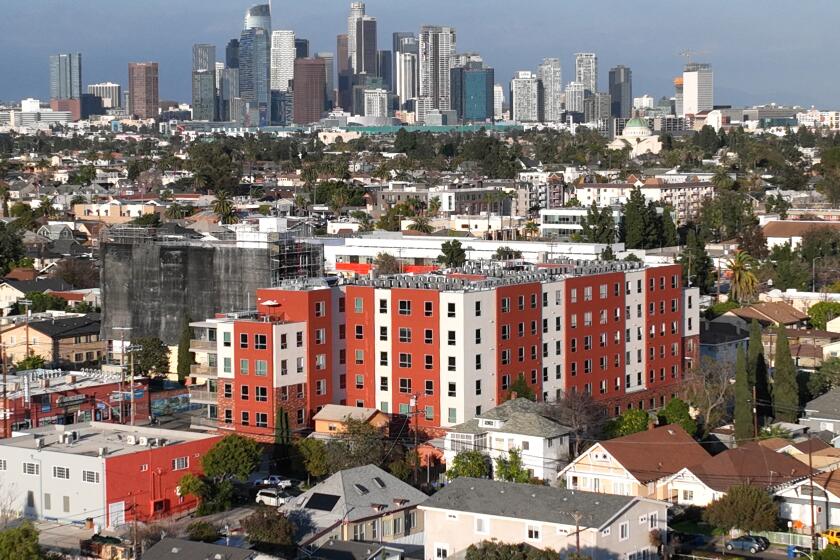UCI Faces Forensic Dilemma
- Share via
Five bodies lie in the ground-floor morgue at UC Irvine’s College of Medicine. No one knows their names.
In itself, that is an embarrassing mystery.
Beyond that, the cadavers pose a ticklish puzzle for university officials: how to identify the bodies without asking distressed families to take part in a grisly scavenger hunt.
The awkward situation stems from a scandal in UCI’s Willed Body Program. University officials fired the program’s director last month, and the district attorney is investigating whether donated bodies were used for private profit.
A university audit found that the program’s computerized records, which tracked bodies, were destroyed by a computer virus. Officials cannot determine what happened to all the cremated ashes or identify all of the 27 bodies that are in the Willed Body Program laboratory in a campus building called Med Surge II. In the meantime, the program has been suspended.
University officials concede that there is a remote possibility that one of the five is a cadaver that was supposed to have been cremated. Relatives of Anneliese Yuenger reported finding a tag among the ashes they received back from UCI that identified the remains as miscellaneous cadaver parts, and officials are not sure when--or if--the 82-year-old Santa Ana woman had been cremated.
To identify the cadavers, as well as to ease fears that other bodies may have been disposed of improperly, university officials announced last week that they will consult a forensic pathologist to help them name the five unknowns.
University officials acknowledge that the mystery presents not just a scientific puzzle but also tricky ethical and public relations problems. Routine analyses--using fingerprints, dental records, DNA sampling or visual identification--may come into play, but each has inherent technical disadvantages. More daunting, some would require an unknown number of people--all possible relatives--to supply tissue samples or allow access to medical records.
“We are trying not to bother the families and yet to collect as much information as we can,” said Dr. Thomas Cesario, dean of the medical school. “Quite honestly, we are trying to find out what is the right information to collect [and] what are the sources one can go to to help identify the bodies.
“You would think these are simple questions, yet we are not professionals at this, and we are trying to get professional help to decide how is the best way to do this.”
Medical school officials have contacted about three dozen donor families to gather or share information. Beyond that, they have said very little about the five or how the investigation is being handled.
Fingerprinting Seen as Starting Point
One thing is virtually certain: Families won’t be asked to go to Med Surge II and individually identify the bodies.
“That stuff where they pull out the drawer [and show relatives a corpse] is passe,” said Los Angeles County coroner spokesman Scott Carrier. “We haven’t done things like that in years . . . since the 1950s or ‘60s.”
Orange County Deputy Coroner Kurt Murine and other forensic scientists recommend fingerprinting as the starting point for the investigation. The Department of Motor Vehicles has digital thumbprints of many drivers, and other donors may have fingerprint records because of security, criminal or employment requirements.
“This information would be the most readily available and could be transmitted over a facsimile machine,” he said.
University officials, however, have suggested that fingerprinting may not be possible in all cases--where dissection has obliterated fingerprints, for example. In other cases, the hands may even have been removed from the body.
Perhaps the biggest stumbling block to fingerprinting is that the victims may have no fingerprints on record, experts said.
At the very least, however, fingerprinting would help limit the investigation. University officials want to minimize the number of families who must be interviewed or asked to provide records or biological samples.
“We want to do it in a way that the families are most comfortable with,” Cesario said. “We want to be sure to do it in a way that doesn’t further violate any trust that we have. We want to rebuild that relationship. We want to be sensitive.”
The Yuengers are eager to help.
“It’s traumatic, but just a fraction more traumatic than what we’ve gone through already,” said Paul Yuenger, Anneliese’s son. “It’s not something we want to do, but it’s something we’re willing to do.”
Forensic experts said the problem of identifying the bodies, while taking place in an unusual context, is fairly routine.
“Bodies will get confused in a number of situations, such as severe damage in an auto accident,” said Dr. Kim Collins, chief medical examiner in Charleston County, S.C., and director of the forensic pathology section at the Medical University of South Carolina. “Sorting them out is pretty standard.”
Others said the university should be able to discreetly get the answers it wants, perhaps in a week.
“Today the university is in an unenviable situation, but that can be corrected,” said Dr. Werner Spitz, a professor of pathology at Detroit’s Wayne State University School of Medicine who testified in the O.J. Simpson civil trial. “If this is approached appropriately and tackled the right way, it can be done without upsetting anyone.”
Collins said that dental record comparison would be the next-best option after fingerprinting. That would be particularly true if the bodies have been dissected, obliterating facial characteristics and even fingerprints.
Dental Records, Photos Also Among Options
Dental chart analysis is commonly used by coroners for burned bodies or other badly decomposed or disfigured bodies. Forensic experts would compare the cadaver’s dental work with the pattern of missing, capped and filled teeth on charts of possible matches.
If those records are unavailable or a match cannot be made, another possibility is presenting suspected relatives with photographs of the unidentified bodies--in black and white to minimize their discomfort. But Orange County Chief Deputy Coroner Jackie Berndt said that visual identification is not reliable.
People may not recognize even a close relative when looking at a photograph of a corpse, she said. “I have been in situations where . . . they don’t recognize them with the muscles relaxed and the mouth dropped down and the [altered] facial color,” she said. “There is a difference in appearance, and people are just not sure.”
A last resort, according to many experts, would be DNA analysis. While the procedure is definitive, it can be costly and time-consuming.
To perform the comparison, experts would first look for DNA profiles on record to compare to the cadavers. Otherwise, a lock of hair saved by a relative or a recent blood sample could be used for matching.
Where such evidence does not exist, DNA identification could still be done by comparison with samples from relatives. A parent or child would provide the best comparison and would achieve a definitive identification, said James C. Pierce, assistant professor of genetics at the University of Sciences in Philadelphia.
Under this so-called DNA fingerprint analysis, the DNA signature is shared 50% between offspring and parents. “It would be absolutely discriminating,” Pierce said. “There would be no doubt about it.”
However daunting UCI’s problem may seem, it pales in comparison to a puzzle Spitz once faced when he was Detroit’s medical examiner two decades ago.
During a bitter labor dispute, someone removed identifying tags from 38 bodies in the morgue, leaving them anonymous. Using everything from fingerprints to dental records and identifying tattoos, Spitz and his staff identified them in a week and didn’t err--many of the bodies were later presented in open caskets.
*
Times staff writer Kate Folmar contributed to this story.
(BEGIN TEXT OF INFOBOX / INFOGRAPHIC)
UCI’s Mystery
UC Irvine medical school officials are calling in outside experts to identify five cadavers whose names have been lost amid a scandal in the school’s Willed Body Program. Forensic scientists say all the methods have advantages and disadvantages:
Fingerprinting
Advantages:
* Minimal trouble for families
* Relatively quick and conclusive
Disadvantages:
* Matching prints may not be on file
* Prints may be impossible to obtain from cadaver
Medical and Dental Records
Advantages:
* Relatively simple procedure
Disadvantages:
* Families must be contacted for access to records
* Comparison records may not be available
Photographs
Advantages:
* Quick and simple procedure
Disadvantages:
* May upset families
* May not be accurate
DNA Analysis
Advantages:
* Virtually positive identification is possible
Disadvantages:
* Families must be asked for DNA samples
* Can be difficult to find DNA samples for comparison
* Expensive, time consuming
Source: Times reporting
More to Read
Sign up for Essential California
The most important California stories and recommendations in your inbox every morning.
You may occasionally receive promotional content from the Los Angeles Times.










